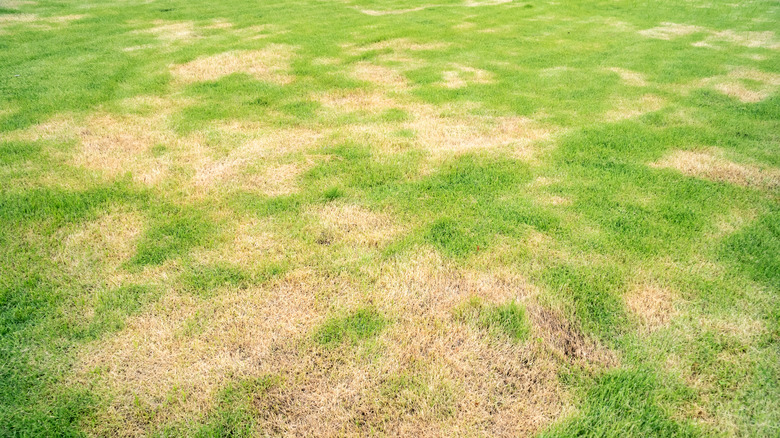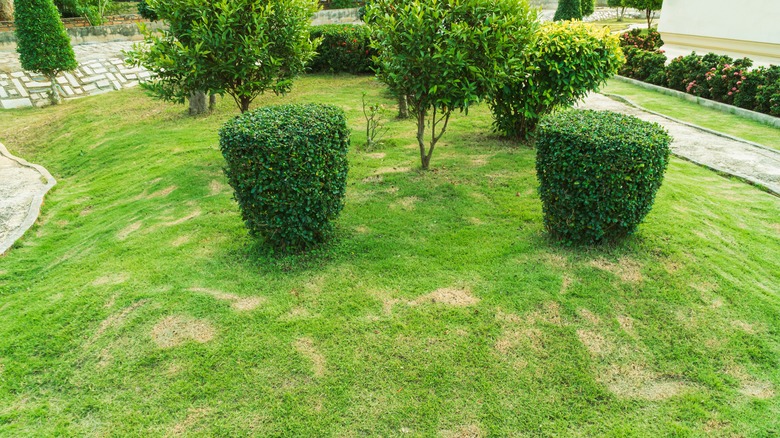When dark, unsightly patches start to make their unwelcome appearance along the damper regions of your lawn, it’s time to sit up and take notice. This issue transcends mere aesthetics; you could be dealing with pythium blight lawn disease, less flatteringly known as grease spot or cottony blight. It has a reputation for its unrelenting assault on cool-season turfgrasses, including the likes of tall fescue, transforming green areas into wastelands of decay. At the heart of this havoc lies the pythium fungus, which finds its bliss in the moisture-laden environments that our lawns often provide.
Navigating the challenges of this disease requires a discerning eye, as it shares a similar look with brown patch lawn disease, leading to potential misdiagnosis. Excess soil moisture, a critical factor in the growth of pythium blight, sets the stage for this fungal drama. Overwatering and bad drainage are the primary causes of this excess moisture. And then there are other issues, like temperature, which facilitate the disease’s proliferation. This is especially the case when evening temperatures reach certain levels. For cool-season grasses, it’s usually 65 degrees Fahrenheit, and 50 degrees Fahrenheit for their warm-season counterparts. This, coupled with a scenario where grass remains drenched for too long, creates the perfect storm for an outbreak. To compound matters, if your soil has a calcium deficit, this may increase the chances of the disease.
Signs and symptoms of pythium blight

The initial warning signs of pythium blight on your lawn are unmistakably troubling. You begin to see patches of grass that look utterly distressed; they’ll likely appear heavily soaked or greasy. These patches have an unnerving tendency to spread out swiftly, decimating the grass in their wake. If you’re out early enough, you might catch sight of the actual fungi blanketing the blades of grass and the soil’s surface. This is your first clue that a fungal invasion is taking place right under your nose.
Yet, the narrative of pythium blight’s impact on your lawn extends beyond these dark, damp patches. The grass caught in the clutches of this disease might also turn a dull gray color under the weight of moisture. As it dries, this grayness fades into a sickly yellow, signaling further distress. More than that, these affected areas tend to link up, creating extensive streaks that snake their way across your lawn. These streaks can be mostly seen on the natural water drainage paths, highlighting the routes of moisture movement and exacerbating the visual and health impact on your lawn. This progression from initial patches to expansive streaks of damage underscores the aggressive nature of pythium blight, making it a formidable adversary for any lawn enthusiast.
Winning the battle against pythium blight and prevention tactics

Tackling pythium blight and ensuring it doesn’t darken your lawn’s doorstep again is no small feat — it requires science, diligence, and a good dose of lawn care wisdom. First things first: you’ll need to reduce your watering frequency. Avoid watering your lawn every day. A little watering goes a long way here. Aim to water just once a week; this still gives your lawn the amount of water it needs without turning it into a fungal playground. When using fertilizers, do so sparingly, aiming for just enough to do the job. You’ll also want to keep your soil’s pH in that sweet spot — not too alkaline, not too acidic. Every few years give your soil a little love with a test. It’s like a health check-up for your ground. This way, you can spot any missing nutrients early on and get them sorted with fertilizer, keeping your turf in tip-top shape.
Now, onto the heavy hitters: fungicides. If you’re planning to use them, opt for those that contain metalaxyl and mefenoxam. These work best, especially when the humidity cranks up and your lawn starts to feel more like a swamp. And if your lawn’s been through the wringer with pythium blight before, consider a regular fungicide routine. A preventative maintenance schedule, with applications every two weeks during those high-risk periods, can keep that relentless fungus in check.




